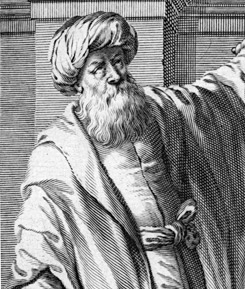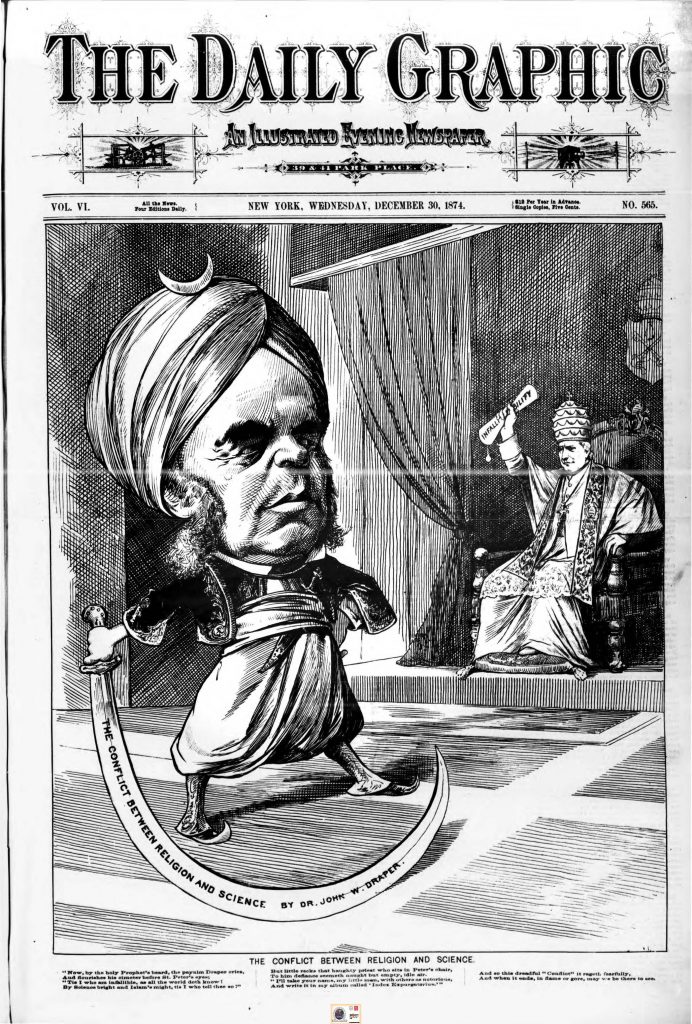
Tyndall, Draper, and “Eastern” Religions
By Bernard Lightman
When John Tyndall, well known physicist and superintendent of the prestigious Royal Institution, delivered his “Belfast Address” in 1874 as President of the British Association for the Advancement of Science he touched off a storm of controversy that lasted for several years. The lecture was a tour de force, covering the entire history of science and its complicated relationship to philosophical materialism, particularly with reference to three new areas of research in nineteenth century science: the conservation of energy in physics, the theory of evolution in biology, and developments in the study of physiological psychology. Near the end of the lecture Tyndall argued forcefully for the intellectual autonomy of science. Any systems which infringed “upon the domain of science,” including theological systems, must “submit to its control.”
Scientists, Tyndall aggressively declared, “claim, and we shall wrest from theology, the entire domain of cosmological theory.” He concluded, rather poetically, with the need for the creative faculties of “man” to explore the great mystery that lay beyond science. It was a theme, Tyndall admitted, that was too great for him to handle. However, it would “be handled by the loftiest minds, when you and I, like streaks of morning cloud, shall have melted into the infinite azure of the past.”[1] Despite Tyndall’s implication that a role for religion remained in appreciating the mystery of life, he was condemned in sermons, pamphlets, and periodical articles for a multitude of sins. His outraged critics accused him of ungodly materialism, moral corruption, abuse of his position as president of the British Association, and promulgating dangerous unBritish ideas that poisoned the intellectual atmosphere of the country.[2] The theme of the foreign nature of Tyndall’s “materialism” in the periodical press is particularly significant.
In an article titled “The New Koran,” the reverend Michael O’Ferrall, S.J. pointed to the similarities between Tyndall’s dogmatic proclamation “There is no God but Matter”, the faith of Mahomet, and the “enlightened philosophy of the Buddhists.” Tyndall’s atomistic pantheism had more in common with Buddhism and Islam than with the anthropomorphic God of Christianity.[3] William Francis Barry, Catholic apologist and essayist, agreed with O’Ferrall that Tyndall’s address was based on ideas that were distinctly unBritish in his 1877 article on “Mr. Tyndall and Contemporary Thought.” Though indebted to German philosophy and ancient Greek atomists, Tyndall’s atheistic pantheism was “the latest form of Buddhism.” Tyndall’s scepticism about reality, his notion of the absorption of the finest intellects into a Nirvana-like azure sky at the end of the address, and his embrace of a morality that dispensed with God, were all doctrines “taught in Eastern regions before any of our modern discoveries had paved its light on the world.” Sarcastically, Barry congratulated Tyndall “in having, in a predatory and Asiatic fashion, invaded the whole realm inhabited by abstract thinkers.”[4] Barry returned to Tyndall’s links to Buddhism in a second article that same year. If he had to give Tyndall’s beliefs a theological designation, he voted for the label Buddhism. “For the creed of an agnostic is antitheism founded on ignorance,” Barry declared, “and as he is the ‘enlightened thinker’ of the West, so the Buddhist tells us in his very name that he vindicates for himself the enlightenment of the East.”[5]
Tyndall was not the only one who was accused of exporting foreign ideas at odds with Christian theology into British intellectual discourse. His friends and allies, Herbert Spencer and T. H. Huxley, were also implicated in the crime. Although O’Ferrall spends most of his time condemning Tyndall in his “The New Koran,” he also points to how Spencer and Huxley shared Tyndall’s belief in the system of Democritus in which the deities are atomic.[6] Throughout the controversy over the “Belfast Address,” Tyndall’s critics agreed that he was typical among modern scientists. His sins were shared by Spencer, Huxley, and other British intellectuals whose naturalistic tendencies and claims to cultural authority threatened the power of Christianity in British society.[7] Here I will ask the question: in what way, if any, did Tyndall knowingly make use of Eastern religions in order to demonstrate the inability of Christian theology to engage in a constructive way with science?

Tyndall’s references to Eastern science and religion are few and far between. If we put the “Belfast Address” to the side for the moment, there are but four short, though significant, discussions of Eastern science and religion in Tyndall’s writings. In his “Miracles and Special Providences” (1867), Tyndall rejects the notion that miracles are an effective cause in the diffusion of a religion. Islam offers proof that a religion can spread widely without miracles. Since miracles are unscientific, Tyndall positions Islam as a superior religion in comparison to Christianity.[8] After the “Belfast Address, Tyndall discussed how religions evolved in “Science and Man” (1877). Quoting Emerson on the importance of religious symbols to be found in the Vedas, Edda and the Koran, Tyndall agreed that ideas of god underwent “various transformations” that baffled “the theologic mechanic who would carve them to dogmatic forms.” Religious symbols were understood by poets who were able to weave them “into our subjective life.”[9] A year later, in his “Professor Virchow and Evolution,” Tyndall defends the position that ethics can survive apart from theology. He quotes approvingly from one of his critics when he describes Buddha as the transcendental incarnation of moral perfection that is divorced entirely from the existence of a God.[10] Finally, in “The Rainbow and its Congeners” (1884), in his overview of those figures who have contributed to a scientific understanding of the rainbow, Tyndall gives full credit to a twelfth century “Arabian mathematician.” Alhazen (Ḥasan Ibn al-Haytham) is the first figure he mentions in his history because before he came on the scene “the views entertained regarding refraction were utterly vague and incorrect.”[11]
Given the obsession of Barry and O’Ferrall with Tyndall’s connection to Eastern religions, we might expect to find the “Belfast Address” filled with references to Buddhism and Islam. But Tyndall only touches on Eastern science and religion in two sections. Near the end of the address, where Tyndall discusses religion and the mystery of life, he anticipates his later comments in “Science and Man.” Here Tyndall waxes poetically about the feelings of awe, reverence, and wonder that have been incorporated “in the Religions of the world” since the earliest time of history. For Tyndall, they are the “immovable basis of the religious sentiment in the nature of man.”[12] Tyndall does not refer specifically to Eastern religions, but he includes them with all of the world religions as having validity and significance. They are an integral part of the evolution of human religion. Tyndall embraced the notion of a deeper truth that united all religions since he was a young man. In a letter dated 1848 to his close friend, the mathematician Thomas Hirst, Tyndall revealed that he owed to Emerson, as well as Thomas Carlyle, the insight that at bottom all religions contained truth. “You will be able to appreciate the truth of popery and of Protestantism, of Mahomed and John Wesley,” Tyndall wrote to Hirst.[13]
In an earlier part of the “Belfast Address” Tyndall presented views on the role of what he called “Arabian” figures in the development of science that are similar to the comments he made in “The Rainbow and its Congerers.” During his overview of the history of science, Tyndall emphasized the role played by Arabian men of science throughout the Middle Ages. “During the drought of the Middle Ages in Christendom,” Tyndall asserts, “the Arabian intellect … was active.” Tyndall relies heavily on the American chemist and historian John William Draper’s A History of the Intellectual Development of Europe (1863) to provide examples, like Alhazen, of what Arabian men of science accomplished. Next, Tyndall quotes Draper’s criticism of past scholars for excluding Arabian scientists from history. “If all this be historic truth (and I have entire confidence in Dr. Draper) well may he ‘deplore the systematic manner in which the literature of Europe has continued to put out of sight our scientific obligations to the Mahomedans.’” In the analysis following this statement, Tyndall goes on to juxtapose the contributions of Mahomedans to science with the anti-scientific position of medieval Christianity.[14] This account leaves no doubt in the readers’ mind as to the superior compatibility of Islam with science, at least during the Middle Ages.

Tyndall’s intellectual debts to Draper are worth considering further, given Draper’s importance in 1874 when Tyndall delivered his “Belfast Address”. This is the year when Draper’s History of the Conflict Between Religion and Science appeared. Tyndall had not read Draper’s new book when he wrote the “Belfast Address,” but it did develop many of the themes from the earlier book. Tyndall used Draper’s History of the Intellectual Development of Europe extensively in preparing for his “Belfast Address”. Draper sent Tyndall a copy of the book shortly after it was published and they carried on a correspondence that lasted until at least the mid 1870’s.[15] Tyndall chose in his address to focus on the development of the history of science in Europe, starting with the ancient Greeks. But Draper’s book on the intellectual development of Europe was much broader in scope. He included several chapters on Hindu theology, Egyptian civilization, and Arabian science, each of which included the term “digression” in their titles. But for Draper, they weren’t really digressions. Indian and Egyptian civilization were considered by him to be “foreign influences” which “affected” European intellectual evolution.
Moreover, Draper believed that civilizations underwent similar evolutionary trajectories, particularly in the development of religion. The “elder branch,” in this case Hinduism, indicated “the path through which the younger is travelling,” the “younger” being Europe. Draper saw the “theology of India” as being “underlaid with Pantheism.” But he found echoes of the Christian trinity in Brahma, Vishnu, and Shiva in the Vedas of Hinduism. Buddhism was the next evolutionary phase, arising ten centuries before Christ appeared. Buddhism had a supreme force rather than a god and nature proceeded according to the laws “which brought it into being.” India had therefore given two distinct philosophical systems to the world, Hinduism, which rested on the concept of matter, and Buddhism, which was based on the idea of force. The account of Mohammed, which is largely positive, emphasizes how science was cultivated by his followers, in comparison to the Catholic Italian system, which was “repulsive” due to its brutality and hatred of intellectual advancement from the 12th to the 15th century. Draper viewed China as an ancient civilization that had entered its Age of Reason, the final evolutionary stage, centuries ago. To the Chinese, Europeans had scarcely emerged from the barbarian stage. Sending missionaries to China was absurd. It was impossible to force the Chinese to convert to the Anglo-American mode of thought, “religious or political.” Draper recommended that Europeans look “with respect on any thing that one third of mankind have concluded it best to do, especially since they have consistently adhered to their determination for several thousand years.”[16]
Although Tyndall focussed more on the history of European science, many of Draper’s ideas on the relationship of older civilizations to the development of Europe are reflected in his account. Tyndall’s critics recognized his debt to Draper. O’Ferrall wondered why “Mr. Tyndall does not, out of love for Dr. Draper, turn aside from the course of his Address to bepraise the enlightened philosophy of the Buddhists.”[17] Barry acknowledged that his readers would have difficulty seeing Tyndall as a Buddhist. “The thing is too far-fetched; it is grotesque. Where can a scientific man have studied Oriental philosophy?” Barry then admits that Tyndall’s Buddhism is not “derived at firsthand from the East.” According to Barry it actually comes from Germany.[18] But he insists that Tyndall can be seen as a Buddhist because in his philosophy of “phenomenism,” when “applied to the problems of God and morality, is simply what we have said, Buddhism.”[19] What Tyndall’s critics were detecting in the “Belfast Address” was his debt to German thinkers like Fichte and Schelling as well as his admiration for American transcendentalists like Emerson, rather than any genuine engagement with Eastern religion other than what he had gained from reading Draper. Tyndall’s pantheism merely had a resemblance to Buddhism. But this complicated point was likely lost on the Victorian reading audience.
Critics of scientific naturalism drew on four main strategies to contain the danger represented by Tyndall and his allies. First, they attempted to saddle scientific naturalists with the labels of atheism and materialism. In other words, they conflated agnosticism and naturalism with atheism and materialism respectively.[20] A second strategy involved linking scientific naturalism with the supposed immorality of avant-garde art and literature, in particular, aestheticism. Darwin, for example, was accused of having transgressed Victorian standards of respectability in his Descent of Man (1871), which supposedly connected him to the notorious poet Algernon Swinburne.[21] A third strategy was built upon the allegation that scientific naturalists had become just as dogmatic as the Christian theologians that they opposed. They presented nothing less than a rigid creed and they tolerated no opposition to it.[22] In this blog I have explored a fourth, and less examined, strategy for undermining scientific naturalism: associating it with Eastern religions, in the hopes that Christian-centric Victorian audiences would recoil in horror from such alien theologies. But Tyndall and Draper responded to their critics by depicting Eastern religions as superior to Christianity since their primary beliefs aligned more easily with modern science. In other words, for Tyndall and Draper there was no conflict between modern science and all religions. Tensions existed only between modern science and the Christian form of religion. No such conflict complicated the relationship between science and Eastern religions.

Bernard Lightman is Distinguished Research Professor in the Humanities Department at York University, and a past president of the History of Science Society (2018-19). For more information see his Research Profile.
[1] John Tyndall, “The Belfast Address,” in Fragments of Science, eighth edition (Longmans, Green, 1892), vol. 2, 197, 201.
[2] Bernard Lightman, “Scientists as Materialists in the Periodical Press: Tyndall’s Belfast Address,” in Science Serialized: Representation of the Sciences in Nineteenth-Century Periodicals, ed. G. Cantor and S. Shuttleworth (Cambridge: MIT Press, 2004), 199-237.
[3] Reverend Michael O’Ferrall, “The New Koran,” The Irish Monthly 2 (1874): 649, 655-656.
[4] [William Francis Barry], “Mr. Tyndall and Contemporary Thought,” Dublin Review 27 (1877): 466, 468.
[5] [William Francis Barry’, “Recent German Thought—Its Influence on Mr. Tyndall,” Dublin Review 19 (1877), 469-470.
[6] O’Ferrall, “The New Koran,” 655.
[7] Lightman, “Scientists as Materialists,” 220-225.
[8] Tyndall, Fragments of Science, vol. 2, 18-19.
[9] Ibid., 357-358.
[10] Ibid., 380.
[11] John Tyndall, “The Rainbow and its Congeners,” in New Fragments, 2nd edn (London: Longmans, Green & Co., 1892), 199.
[12] Tyndall, Fragments of Science, vol. 2, 196.
[13] John Tyndall to Thomas Hirst, [21] Nov. 1848, Melinda Baldwin and Janet Browne, The Correspondence of John Tyndall (Pittsburgh: University of Pittsburgh Press, 2016), vol. 2, 297.
[14] Tyndall, Fragments of Science, vol. 2, 151-152.
[15] Bernard Lightman, “The Victorians: Tyndall and Draper,” in The Warfare Between Science and Religion: The Idea that Wouldn’t Die, ed. Jeff Hardin, Ronald L. Numbers, and Ronald Binzley (Baltimore: Johns Hopkins University Press, 2018, 65-83.
[16] John William Draper, A History of the Intellectual Development of Europe (N.Y.: Harper & Brothers, 1863), 41, 43, 47, 48, 51-52, 176, 245, 248, 364, 617-619.
[17] O’Ferrall, “The New Koran,” 659. In a note on the same page O’Ferrall tells the reader to “see Dr. Draper’s admiring estimate of the Buddhist Cosmogony” in A History of the Intellectual Development of Europe.
[18] Tyndall’s debt to German romanticism, via Carlyle, has long been recognized by historians. See Frank Turner, “Victorian Scientific Naturalism and Thomas Carlyle,” Victorian Studies 18 (1975): 325-343.
[19] Barry, “Recent German Thought,” 470-471.
[20] Bernard Lightman, “Nineteenth-century science and Western materialisms,” in Science and Narratives of Nature: East and West, ed. Jobin. M. Kanjirakkat, Gordon McOuat, and Sundar Sarukkai (New Dehli, London, and New York: Routledge, 2015), 174-194.
[21] Gowan Dawson, Darwin, Literature and Victorian Respectability (Cambridge: Cambridge University Press, 2007), 26-82.
[22] Bernard Lightman, “The Creed of Science and Its Critics,” The Victorian World, ed. Martin Hewitt (London and New York: Routledge, 2012), 449-465.
